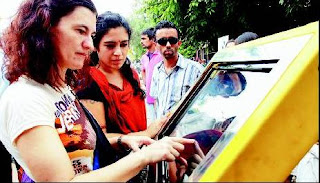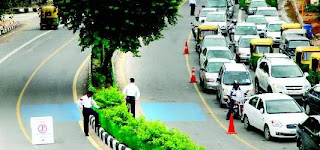With the movement of over 1,600 Bluelines curtailed on 139 routes, bus commuters faced a harrowing time on Monday.
The waiting time at bus stops in east, northeast south and central Delhi was as high as one hour on some routes and commuters could be seen hanging from buses during the office hours. Transport department officials claimed they are putting more buses on the roads to meet the passenger demand and relief can be expected in the next 1-2 days. The Bluelines will be back after the Games on October 16.
During office hours, major bus stops in the affected areas could be seen overflowing with passengers. People complained of long waits for buses and increased travel time. ‘‘I waited for one hour to get a bus on route 445 from Kailash Colony to get to ITO. Normally, I get a bus within 10 minutes but the wait didn’t seem to end on Monday,’’ said Dipak Jha, a Central government employee.
Even those who were fortunate enough to get a bus had to brave crowd or hang from footboards. ‘‘I could barely breathe in the DTC bus I took on route 511. I was forced to get off two stops later and took an auto back to Sarita Vihar,’’ said Swati Kedarnath, a student of south campus. On routes where DTC services were good earlier, commuters felt the pinch in the afternoon when the number of buses were fewer. Delhi Metro recorded a rider ship of 12.62 lakh, which is about 65,000 more than usual.
The government, meanwhile, contended that over 4,140 DTC buses were plying on Delhi roads on Monday, highest ever run by the corporation and an addition of about 2,000 over the normal. But despite that, buses ran packed to capacity on certain routes. Officials claimed the main issue with Bluelines is that the actual number of buses plying on lucrative routes is different from what exists in the records of the transport department. So even after the government put more buses on the roads, commuters felt a shortage.
‘‘There were problems on some of the routes in the morning which are being addressed. We put more buses on routes in Laxmi Nagar and Dhaula Kuan where problems were reported. There is no shortage of buses. The system just needs to be fine tuned. We expect situation will be fine in 1-2 days,’’ said Arvinder Singh Lovely, transport minister.
The transport department held a meeting with Bluelines operators and took a decision to give them alternative routes in rural areas in place of their existing permits for NDMC areas. But according to sources, barely 12 operators have come forward for this.
In all, Bluelines were totally phased out from 68 routes including 490, 544, 512, 413, 280, 281, 378, 391, 680, 309, 26, 729, 364, 501, 503, 621, 533, 502, 543, 611, 703, 500, 520, 580, 548, 540, 47, 894, 894A, 118, 306, 307, 301, 301A, 455, 415, 422, 403, 405, 405A, 409, 425, 425A, 425L, 429, 435, 435L, 438, 445, 449, 460, 433, 507, 507A, 473, 770, 781, 727, 411, 419A, 423A, 427, 440, 463, 469, 522A, 534, 450, 604, 610, 620, 615, 581, 511, 505.
Another 71 routes were curtailed and buses had to turn around from a point near Games zones. Such routes included 375, 536, 984A, 567, 442, 447, 529, 320, 340, 350, 951, 957, 966, 980, 784, 944, 19+19A, 39, 166, 910, 940, 943, 970, GL-90, 181, 410, MS(+)(-), TMS (+)(-) Mudrika route, 990, 990 Extra, 85, 261, 313, 851, 871, 308, 711, 724, 810, 874, 588, 740, 100, 172, 568, 569, 918, GL91, 335, 516, 517, 519, 523, 374, 317, 725, 623, 578, 790A, 214, 214A, 246, 901, 216, 350, 358, 448A, 479, 720, 753, 753A, 764, 893, 763L, 715.





